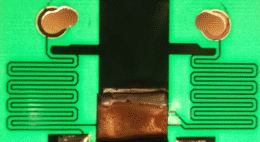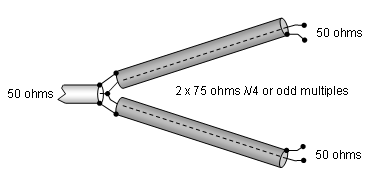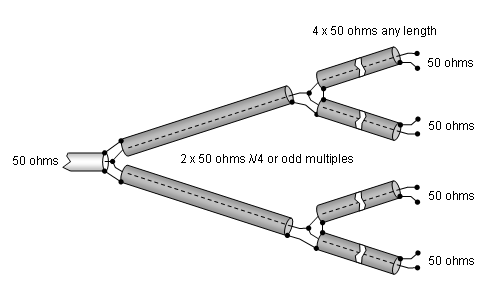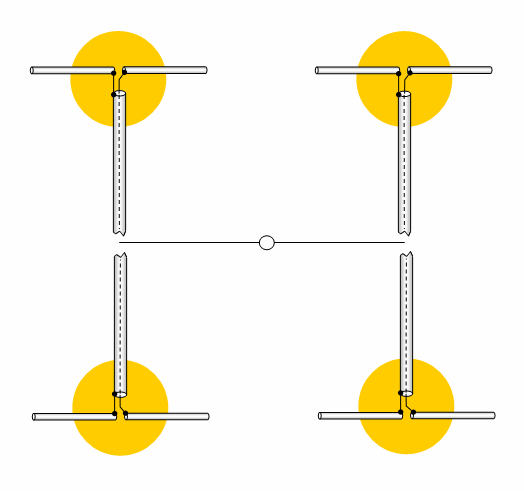Coax Transformers[转载]

Coax Transformers
How to determine the needed Z for a wanted Quarter Wave Lines tranformation ratio

Some applied examples
- 1. From 50 ohms feedline to 12.5 ohms Yagi with straight split DE?
- Z = sqrt ( 50 ohms x 12.5 ohms) = 25 ohms
- This we can produce by using two 50 ohms Quarter Wave Lines in parallel
- 2. From 50 ohms feedline to 28 ohms Yagi with straight split DE?
- Z = sqrt ( 50 ohms x 28 ohms) = 37.4 ohms
- This we nearly can produce by using two 75 ohms Quarter Wave Lines in parallel
- 3. And finally the trivial case:
- From 50 ohms feedline to 50 ohms Yagi with straight split DE?
- Z = sqrt ( 50 ohms x 50 ohms) = 50 ohms
How to transform from 50 ohms to 12.5 ohms using parallel Quarter Wave Lines

How to transform from 50 ohms to 28 ohms using parallel Quarter Wave Lines (aka DK7ZB - Match)

How to transform from 50 ohms to 200 ohms using parallel Quarter Wave Lines // corrected 2014-09-23, tnx DH1LM,
who showed me that the old sketch was wrong. Hopefully this one does ...

Using Quarter Wave Lines this way works as a series collection actually, Z is 100 ohms, Za = 50 ohms, Zb = 200 ohms
How to transform from 50 ohms to 75 ohms using parallel Twelfth Wave Lines

![]()
How produce Ferrite RF Transformers for various impedances transformation ratios
• Ferrite Transformer
Image shows a 1:1 transformer as blue and black wires windings
ratio is 1:1. This one is for Shortwave use. For VHF / UHF dimensions must be much smaller.

Windings N1/N2 ratio by square is transformation ratio for impedance:
Example: Za = 50 ohms, Zb = 200 ohms ...
Na = 6 wdg; Nb = 12 wdg => Na/Nb = 6/12 = 0.5
Transformation ratio = (Na/Nb)xy2 = 0.25 = 1/4 or 1:4
200 ohms x 0.25 = 50 ohms
• Balun Transformer

The Balun transformer is a two-in-one device:
The transformation ratio is same as described above, but now the 50 ohms side is unbalanced (coax feed)
while the 200 ohms side is balanced or symmetrical.
An often seeked for transformation ratio might be 50 to 75 ohms.
This could be acheived using 6 and 9 wdg. respectively 6 + 3 wdg on the Balun Transformer.
• What about the size of the ferrite then?
For any receiving purpose it may be very small. Same to the wire diameters. A tiny ferrite bead equipped with 0.12 mm or so enameled copper wire will do for most purposes. For handling transmitting power or limits issuing intermodulation there is one rule: The ferrite must not saturate. Big is beautiful and size does matter here. Unlike with applications for short wave where ferrite baluns in transmitting antennas are widely used we have only few data and less working ferrite materials when we talk VHF / UHF applications. A rule of thumbs is .. it must not heat up much, it shall not get hot of very warm during transmitting. Having large size ferrites and wires wrapped around is in contradiction to the need for shortest wires on VHF / UHF. That is why we find receiving purpose small ferrite bead based transformers often, but power handling transmitting transformer very seldom here.
Real dimensions: using very small double hole ferrites in a 144 MHz RX frontend

they do not need to be as tiny as that, but to give an impression ...

However here is a little table holding some suitable types, makes and sizes for VHF / UHF transmitting purpose ferrite transformers
Size Amidon T37 or T50, inner diam. = 5.21 / 7.70 mm fit RG58 and RG142 B/U Teflon coax.
Size Amidon T80, inner diam. = 12.60 mm fits RG213 coax, Aircell ...
Code T50-0 (color code: brown) covers 50-300 MHz
Material 43 is for blocking VHF/UHF frequencies
A good choice are the following cores:
FT 50 B-43 inner diam. 7.9 mm, outer diam 12.7 mm, length 12.7 mm (approx EUR 3 pp.)
FB-43-5621 inner diam. 6.4 mm, outer diam. 14.3 mm, length 28.6 mm
FB 43-1020 inner diam. 12.7 mm, outer diam. 25.4 mm, length 28.2 mm
![]()
A commerially made broad band Transformer to match 75 ohms feedline coax to a 300 ohms UHF TV antenna
PCB with inductances.
Designing something like this is rather complex and usually done using an 'EM' software like Sonnet EM, FEKO, ADS ... . So I just show an example. For those who want to dig themselfs into the topic: There are free, limited in size of analysed object versions like 'Sonnet EM Lite' available.

For an etched on PCB solution for 70 cm Amateur Radio Band that does 50 to 28 ohms see here ![]()
![]()
How to transform from 50 ohms to 200 ohms to feed a Folded Dipole as Driven Element

The transformation ratio of a Half Wave "Diversion" Line is 1:4.
What to avoid feeding a Folded DE

Do not attach the feeding coax in a way as shown above so that the coax loop forms anything close to Quarter Wave Line in series to the Balun. Being close to Quarter Lambda it might interfere seriously with the Balun and you end up with bad VSWR on a nice antenna probably. Most attention must be paid if the Balun side of the FD is free floating i.e. not connected to gnd respectively boom.
Tape it to the boom right from the connector or box on, or leave it hanging for much longer than λ/4 x v-factor.
![]()
Note: Any odd multiple of λ/4 such as 5/4 λ or 7/4 λ will transform exactly as the sole λ/4 line. Why so?
Because a half wave line does not change anything, apart from losses. Any odd number of λ/4 can be seen as a number of half wave lines plus a single λ/4 wave line.

Practical hint: I used a quality coaxial 432 MHz 4 x power splitter for joining four 1296 MHz Yagis on serveral contest occasions with good success.
Same would apply to 144 MHz splitters to use on 432 Mhz and so forth. Any tripple frequency ... just mind connecting bushings pins inductances or coax pigtails that have more impact on that tripple frequency.
Feeding stacked Antennas with Coax
How to feed two 25 ohm Antennas from 50 ohm coax

How to feed two 50 ohm Antennas from 50 ohm coax

How to feed four 50 ohm Antennas from 50 ohm coax

A conventient way to feed a 4 Yagi stack. 4 x 50 ohms any length means any length but all four of same length.
How to feed four 50 ohm Antennas in typical H-configuration from 50 ohm coax in style

A classical 4 Yagi stack may be fed and phased using 50 ohms coax efficiently when using odd multiples of λ/4 like 5/4 λ for making the horizontal phasing lines. An example: At a given stacking distance of 3.0 m the 5/4 λ equals 5 x 0.34 m = 1.7 m roughly on 144 MHz whe taking the v-factor for PE coax into account. That makes it 1.7 m to the left plus 1.7 m to the right. Enough to bridge over the two H-frame tubes.
![]()
How to get four Folded Dipoles fed in phase

It is understood that all feeding coaxes must be of similar length and impedances must be transformed as shown above or using a Power Splitter ![]()
• All shields are to be connected on same side
• All Folded Dipoles are facing upwards
... which in typical H-frame 4 bay configuration involves turning the struts of the lower pair upside down while elements and Dipole stay as on the upper pair. Or simply put: all dipole boxes or Matches face down.
![]()
How to get four Straight Split Dipoles fed in phase

It is understood that all feeding coaxes must be of similar length and impedances must be transformed as shown above or using a Power Splitter ![]()
• All shields are to be connected on same side
![]()
How to get a vertical 4 Yagi stack fed in phase

In General:
It is understood that all feeding coaxes (1,2,3,4) must be of similar length and impedances must be transformed as shown above or using a Power Splitter ![]()
Specificly:
Using similar lengths for all four feeding coaxes needs somehow winding up # 2 and 3. We find a remedy here using a length of minus full 360 degr. for the inner coaxes # 2, 3. As 360 degr. or even multiples of that do not change anything according feeding phase. With a lag of n x 360 degr. we are just at the same point on the sinus we find on the outer Yagis. Which in practise means we are feeding all dipoles in phase.
An example: 360 degr. is just 1.0 wavelength, multiplied with real velocity factor of coax to be used at designated frequency. Likewise v = 0.82 of some foam insulated coax on 144.1 MHz (2.080 m) makes 360 degr. of runtime on coax be equivalent to a length of 1.706 m Simply put: coaxes # 2, 3 can be 1.706 m shorter than the coaxes # 1, 4 feeding the outer dipoles.
• All shields are to be connected on same side
Coax Transformers[转载]的更多相关文章
- maven package 知识(转载)
“打包“这个词听起来比较土,比较正式的说法应该是”构建项目软件包“,具体说就是将项目中的各种文件,比如源代码.编译生成的字节码.配置文件.文档,按照规范的格式生成归档,最常见的当然就是JAR包和WAR ...
- Hibernate使用原生SQL(转载)
本文转载,出处如下:http://bhdweb.iteye.com/blog/801084 HQL尽管容易使用,但是在一些复杂的数据操作上功能有限.特别是在实现复杂的报表统计与计算,以及多表连接查询上 ...
- [转载] Kafka+Storm+HDFS整合实践
转载自http://www.tuicool.com/articles/NzyqAn 在基于Hadoop平台的很多应用场景中,我们需要对数据进行离线和实时分析,离线分析可以很容易地借助于Hive来实现统 ...
- [转载] 基于Dubbo框架构建分布式服务
转载自http://shiyanjun.cn/archives/1075.html Dubbo是Alibaba开源的分布式服务框架,我们可以非常容易地通过Dubbo来构建分布式服务,并根据自己实际业务 ...
- 转载maven安装,配置,入门
转载:http://www.cnblogs.com/dcba1112/archive/2011/05/01/2033805.html 本书代码下载 大家可以从我的网站下载本书的代码:http://ww ...
- Crystal Clear Applied: The Seven Properties of Running an Agile Project (转载)
作者Alistair Cockburn, Crystal Clear的7个成功要素,写得挺好. 敏捷方法的关注点,大家可以参考,太激动所以转载了. 原文:http://www.informit.com ...
- RTP与RTCP协议介绍(转载)
RTSP发起/终结流媒体.RTP传输流媒体数据 .RTCP对RTP进行控制,同步.RTP中没有连接的概念,本身并不能为按序传输数据包提供可靠的保证,也不提供流量控制和拥塞控制,这些都由RTCP来负责完 ...
- 《Walking the callstack(转载)》
本文转载自:https://www.codeproject.com/articles/11132/walking-the-callstack Download demo project with so ...
- [转载]MVVM模式原理分析及实践
没有找到很好的MVVM模式介绍文章,简单找了一篇,分享一下.MVVM实现了UI\UE设计师(Expression Blend 4设计界面)和软件工程师的合理分工,在SilverLight.WPF.Wi ...
随机推荐
- C#开发中可能会用到的一些小贴士(转)
转至http://www.cnblogs.com/Ebony-Ivory/p/4380106.html C#篇: 1.目标平台的选择 64位操作系统在编译VS里的程序时,根据需要设置项目属性的“目标平 ...
- AC自动机(1)
Description Ignatius最近遇到一个难题,老师交给他很多单词(只有小写字母组成,不会有重复的单词出现),现在老师要他统计出以某个字符串为前缀的单词数量(单词本身也是自己的前缀). ...
- springMVC图片文件上传功能的实现
在工程依赖库下添加文件上传jar包 commons-fileupload-1.2.2.jar commons-io-2.4.jar 2.jsp页面设置form表单属性enctype 在表单中上传图片时 ...
- Linux命令详解之—pwd命令
Linux的pwd命令也是一个非常常用的命令,本文为大家介绍下Linux中pwd命令的用法. 更多Linux命令详情请看:Linux命令速查手册 Linux pwd命令用于显示工作目录. 执行pwd指 ...
- ahjesus C# 4.0 Parallel 并行运算
Parallel.For - for 循环的并行运算 Parallel.ForEach - foreach 循环的并行运算 Parallel.Invoke - 并行调用多个任务 Task - 任务,基 ...
- 基于进程的Quartz.NET管理系统QuartzService(一)
需求 在处理定时任务大家可能都用过Quartz.NET,但在生产环境中大家肯定也遇到过如下的问题: 发布的时候需要停掉所有的Job,再整个一起打包发布 没有管理界面(其实在github也有几个这方面的 ...
- ASP.NET Core 1.0开发Web API程序
.NET Core版本:1.0.0-rc2Visual Studio版本:Microsoft Visual Studio Community 2015 Update 2开发及运行平台:Windows ...
- dbcp/c3p0连接池设置mysql会话变量
我们有几个计算风控值的定时任务,几乎每隔5秒会更新所有账户的当前总资产并以此通知风控,每隔一小时就产生一两个G的binlog,几十台服务器折腾..数据库是公用的,代码是通过工具自动生成的,直接修改流程 ...
- Tomcat/JSP中文编码配置
来源:http://blog.csdn.net/zhangzikui/article/details/6169978 http://www.iteye.com/topic/300656 ...
- RadioButton 自定义控件
在res/drawable新建radiobutton.xml(本案例为video——evaluate.xml)如下 <?xml version="1.0" encoding= ...
